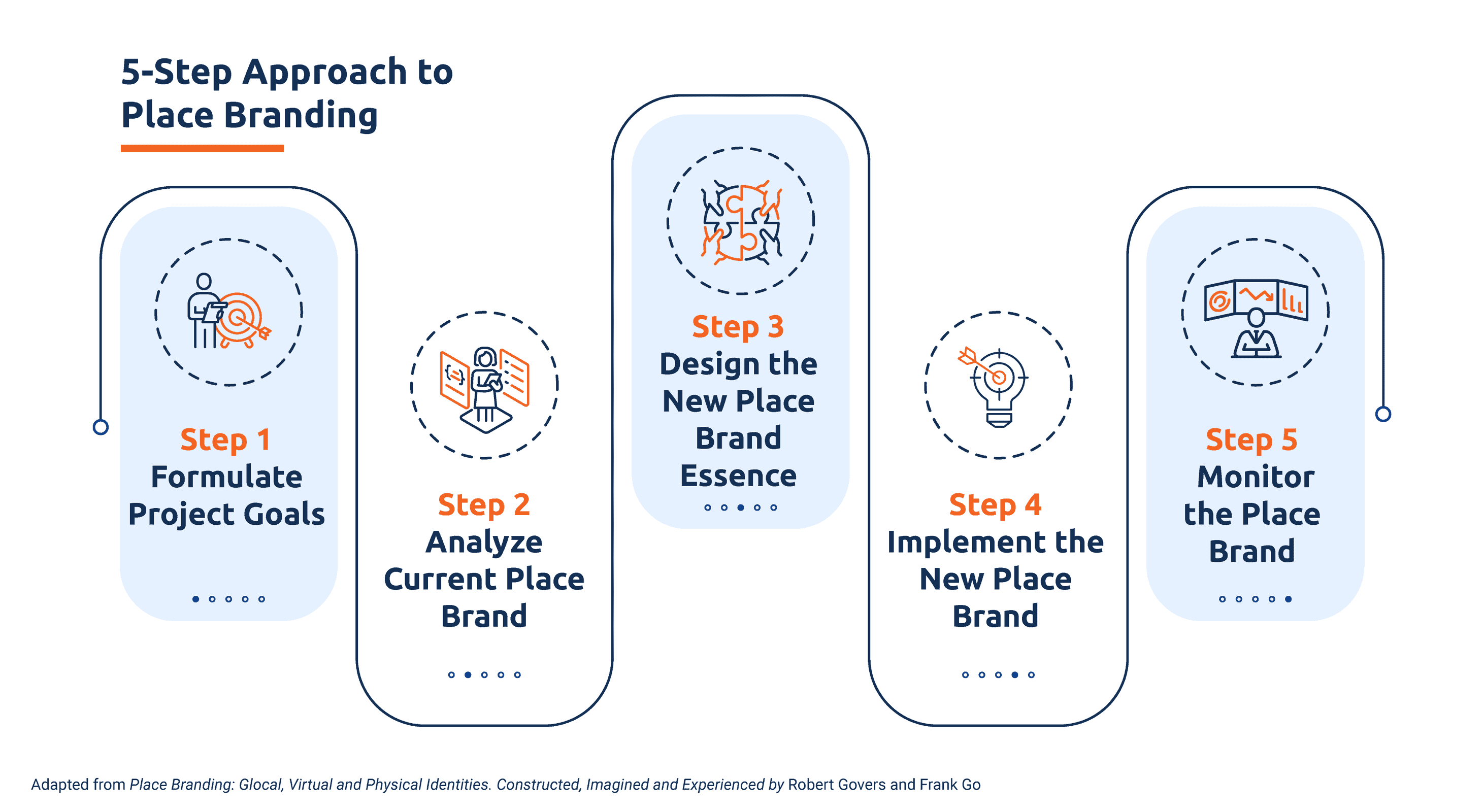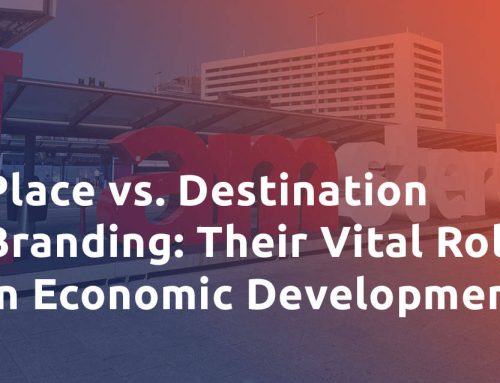As we continue into our mini-series, we are exploring the nuances of branding in economic development in greater detail. As outlined in Part 1: Place Vs. Destination Branding: Their Vital Role in Economic Development, place branding has taken center stage among strategies adopted by economic development professionals for regional brand development.
In this installment, we are focusing on the concept of place branding, diving deeper into the place branding process, exploring the principles that guide successful place branding campaigns and the steps that economic development professionals can take to employ these concepts in their investment attraction strategies.
The 5 Principles of Successful Place Branding
Place branding is more than just a marketing tool—it bridges the gap between the identity of a place; its offerings; the experience that visitors (tourists, potential investors and prospective residents) get when they visit; and the perception that others have of a place.
Strategically applied, place branding can stamp your region on the world map, accentuating its strengths and setting it apart from competitors. By showcasing potential to stakeholders, it can significantly enhance a region’s competitiveness both domestically and internationally.
Robert Govers, the founding president of the International Place Branding Association (IPBA), together with Erik van ‘t Klooster and Gerard Van Keken, developed the following set of 5 principles to guide the development successful place branding:
1. Distinctiveness
Place branding is above all about what makes your region unique. What makes your region stand out against others? What does your region offer that its competitors cannot? Successful place branding campaigns clearly define the unique characteristics of a region and highlight how these distinctions bring value to the target audience.
2. Authenticity
Place branding should truthfully reflect a region’s character, values, and identity. It’s vital to create a connection between existing local perceptions and the image you aim to project. This balance guarantees credibility and fosters trust between your audience and your regional brand image.
3. Memorability
Successful place branding leaves a durable, distinct impression on its target audience. It creates memorable experiences that entice visitors to consider living, returning to, or investing in your region.
4. Co-Creation
Successful place branding campaigns are not top-down affairs; they thrive on the collaboration of all stakeholders involved, ranging from government to companies and civil society.
5. Place Making
Finally, successful place branding is not about a good slogan, logo and nice promotional campaigns. The place branding campaigns that are most successful go beyond just the marketing; it creates a cohesive sense of place. This requires collaboration and integration of the place branding into all aspects of a place. Successful campaigns are supported by policies, innovations, events, structures, investments and symbolic actions.
The Place Branding Process
Strategically implementing place branding can strongly enhance your region’s visibility, competitiveness, and overall appeal, ultimately driving economic growth and prosperity. However, developing and implementing an effective and comprehensive place brand can be a complex process.
It’s crucial to note that place branding isn’t linear like product or company branding. It comprises several sub-processes, involving numerous stakeholders. Nonetheless, simplifying this process is achievable by following five primary steps:

Step 1: Formulate Project Goals
The first step involves defining the vision, mission, and objectives of your Place Branding initiative. Clear definition of these aspects is necessary before commencement. You need to first develop a realistic image for your place. This process should be done in collaboration with key local stakeholders to ensure the vision is supported. Your vision should focus on the distinctive features your region offers that others cannot imitate.
Once your vision is established, you should summarize the vision and purpose of your Place Branding project into a mission statement. Your statement should focus on the competitive advantages you offer, your target audience and the desired benefits your place branding aims to bring to the community.
Finally, the objectives of your place branding must also be clearly explained in your mission statement. You can break these down into measurable goals. Ensure that all your objectives are SMART: specific, measurable, achievable, realistic, timely.
Step 2: Analyze the Current Place Brand
The next step is to analyze your current place brand. To do this you must examine three key perspectives: the place identity, the perceived place image and the projected place image. These three perspectives must be clearly examined, understood and aligned.
As explained in the principles of successful place branding, your place branding must be authentic to be successful, and by aligning these three perspectives you are able to develop a strong, authentic and consistent brand, with a reputation that is based on a coherent, compelling and unique sense of place.
Step 3: Design the New Place Brand Essence
Once you have completed your current place brand analysis and laid out your goals, it is time to design your new brand essence. This includes your values, narrative, visual identity, name and scope. These should all remain authentic to the characteristics of the place, the services offered, and the audience you want to reach.
Authentic brand values will create a sense of belonging and purpose that reflects authenticity and consistency to your audience. Ensure that the values of your place brand match those of your target audience.
Step 4: Implement the New Place Brand
For successful place branding, concerted efforts need to go into place development (place making), communication and cooperation.
Successful place branding requires actual place development. This encompasses infrastructural development, monetary investments, and policy support that align with the place brand’s vision.
After your place brand implementation, maintenance should follow. Keep pushing your message through suitable channels, which will require understanding SEO, online marketing, and community building. Also, ensure all stakeholders warmly welcome and embody your place brand.
Step 5: Monitor the Place Brand
The final step involves monitoring your place brand and periodically assessing its effectiveness through brand awareness and how the image is perceived and projected.
Carry out periodic surveys on your target audience to assess awareness levels. Assess perceptions across all sectors of your target audience, compare over time and against competitors to gauge success.
You can also gauge success through the perceived brand image of your place. By capturing the perceptions of various stakeholders like investors and visitors, you can assess your place branding success over time and in comparison to competitors.
Last but not least, the feedback about your brand image serves as another success indicator. Monitoring media coverage, online community discussions, and local stakeholder opinions offers insight into the effectiveness of your brand image.
Final Thoughts: The Place Branding Process
Place branding is more than just marketing a region. It creates a cohesive and lasting identity for a place. Developing a place brand is not easy, it is a complex process that requires a deep understanding of your region and must include local stakeholders in the conversation. However, the process can be guided and simplified by following the principles of successful place branding.
By acknowledging the principles outlined here, economic development professionals can make effective use of place branding in their investment attraction and marketing strategies, reaping the benefits of this top-tier strategy, and driving their region’s economic growth and prosperity.
Stay tuned for the final installment of this series, where we will dive deeper into the destination branding processes and the steps that economic development professionals can take to employ destination branding in their investment attraction and marketing strategies.







